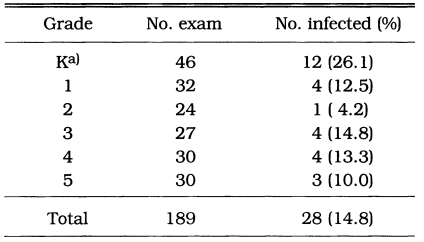Abstract
The egg positive rate of Enterobius vermicularis was investigated among students of a primary school and a kindergarten located in the rural area of Tangjin-gun, Chungchongnam-do in December, 1998. Of the 189 examinees, 28 (14.8%) were found to be infected with E. vermicularis by the adhesive cellotape anal swab method. The infection rates ranged from 4.2% to 26.1% among school children, and the highest rate was observed in children attending kindergarten. Three months after treatment with albendazole, four (14.3%) out of 28 infected children still remained infected with E. vermicularis. Through this survey, we were able to determine that E. vermicularis infection is still prevalent among children in rural areas of Korea.
Keywords: Enterobius vermicularis, epidemiology, primary school children, albendazole
Enterobius vermicularis is an important human parasite which causes symptoms including anal itching, abdominal disturbance, appendicitis or chronic salphingitis, and sometimes involves colon and genital tract (Beaver et al., 1984). The eggs of E. vermicularis can not be detected easily by usual fecal examination and enterobiasis is not a common parasitic disease in present years, but there have been limited reports on the infection status in general population. To evaluate the status of E. vermicularis infection in primary school children, we visited a primary school in agricultural area located in Tangjin-gun Chungchongnam-do in December in 1998. The survey was done by the adhesive cellotape anal swab methods from 9 to 11 in the morning. Each grade consisted of one classroom and the examination was carried out with all children who attended that day.
Of the 189 examinee, 28 (14.8%) were egg positive. The infection rate in 46 kindergarten children was 26% and infected children were found from every grade.
The egg positive children were treated with 400 mg albendazole twice with 2 weeks interval and reexamined three months later. Among the 28 examinee who had been infected with E. vermicularis, 4 children were egg positive. The egg negative conversion rate was 85.7%.
Routine stool examination methods, such as formalin-ether concentration method and cellophane thick smear, showed that the E. vermicularis infection rate to be 0.1% among the inhabitants in the upper stream of Kumgang (River) and 0.02% among the patients who had visited Seoul Paik Hosptial (Kim et al., 1994; Lee et al., 1994). It meant that only a limited portion of E. vermicularis could be detected by ordinary stool examination method. In this survey, we performed only one anal swab test for E. vermicularis infection. Therefore, many false negatives could have been undetected. It has been reported that 3 consecutive examinations with 4 to 5 day time intervals improved the detection rate of E. vermicularis from 50% to 87.5% (Kim et al., 1991). Since the life cycle of the parasite and children's habits affect the control of E. vermicularis, a strict control or extermination of enterobiasis is difficult. Eggs of E. vermicularis have a short incubation period of about 6 hours in anus for hatching(Cram, 1943); therefore, infection from anus to mouth easily occurs. In more severe cases, retroinfection or vaginal invasion can be established. The family of an infected child should be treated at the same time, and underwears and bedclothes of the infected child should be sterilized (Garcia and Bruckner, 1997).
E. vermicularis infection seems prevalent in children of rural areas in Korea and there should be more extended survey for the infection status and adequate trials for treatment are required to provide better life conditions for school children.
Table 1.
Egg positive rate of Enterobius vermicularis by grade in a primary school
a)Kindergarten annexed to the primary school
ACKNOWLEDGEMENT
We thank The Korea Association of Health for their support of antihelminthics used in this study.
References
- 1.Beaver PC, Jung RC, Cupp EW. Clinical parasitology. 9th ed. Philadelphia, USA: Lea & Febiger; 1984. pp. 302–306. [Google Scholar]
- 2.Cram EB. Studies on oxyuriasis XXVIII. Summaries and conclusions. Am J Dis Child. 1943;65:46–59. [Google Scholar]
- 3.Garcia LS, Bruckner DA. Diagnostic medical parasitology. 3rd ed. Washington, D.C., USA: ASM Press; 1997. pp. 229–231. [Google Scholar]
- 4.Kim JS, Lee HY, Ahn YK. Prevalence of Enterobius vermicularis infection and preventive effects of mass treatment among children in rural and urban areas, and children in orphanages. Korean J Parasitol. 1991;29:235–243. doi: 10.3347/kjp.1991.29.3.235. [DOI] [PubMed] [Google Scholar]
- 5.Kim CH, Na YE, Kim NM, Shin DW, Chang DY. Intestinal parasite and Clonorchis sinensis infection among the inhabitants in the upper stream of Taechong Dam, Kumgang. Korean J Parasitol. 1994;32:207–214. doi: 10.3347/kjp.1994.32.4.207. [DOI] [PubMed] [Google Scholar]
- 6.Lee SK, Shin BM, Chung NS, Chai JY, Lee SH. Second report on intestinal parasites among the patients of Seoul Paik Hospital (1984-1992) Korean J Parasitol. 1994;32:27–33. doi: 10.3347/kjp.1994.32.1.27. [DOI] [PubMed] [Google Scholar]



